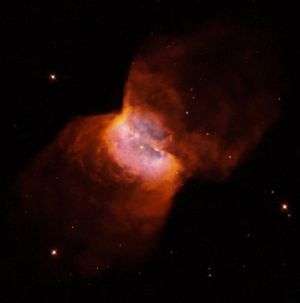NGC 2346
| Nebula | |
|---|---|
|
NGC 2346 imaged by the Hubble Space Telescope | |
| Observation data: J2000.0 epoch | |
| Right ascension | 07h 09m 22.52s |
| Declination | -0° 48′ 23.6" |
| Distance | 2 kly ly |
| Apparent magnitude (V) | 11.6 |
| Apparent dimensions (V) | 0.9′ |
| Constellation | Monoceros |
| Designations | Butterfly Nebula |

NGC 2346 (also known as the Butterfly Nebula) is a planetary nebula near the celestial equator in the constellation Monoceros.[1] It is bright and conspicuous and has been extensively studied. Among its most remarkable characteristics is its unusually cool central star, which is a spectroscopic binary, and its unusual shape.
The binary star, which has a period of about 16 days, is also variable, probably due to dust in orbit around it. The dust itself is heated by the central star and so NGC 2346 is unusually bright in the infrared part of the spectrum. When one of the two stars evolved into a red giant, it engulfed its companion, which stripped away a ring of material from the larger star’s atmosphere. When the red giant’s core was exposed, a fast stellar wind inflated two ‘bubbles’ from either side of the ring.
